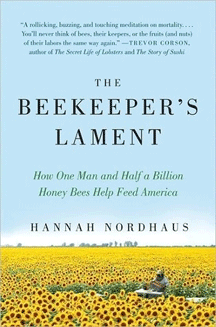By Germaine Cornelissen-Guillaume
The author uses her journalistic skills to tell the compelling story of John Miller, a migratory beekeeper, as he travels the country with thousands of hives chasing blooms and making honey. Along the way, the reader learns many interesting facts about bees and their queens, about beehives, and about the multiple challenges faced by a dwindling population of commercial beekeepers.
Hannah Nordhaus reviews major known factors responsible for the loss of bees nationwide. Among pesticides, the impact of using neonicotinoid systemic pesticides (that get into every part of the plant, including the pollen) is discussed in relation to the much publicized Colony Collapse Disorder, responsible for large losses of bee colonies in recent years. New data published by
Science Magazine earlier this year add evidence relating their use to the problem, leading some scientists to call for regulators to consider banning this class of chemicals. There is, however, no consensus on the issue, and the prevailing view remains that complex interactions among multiple stressors are to blame.
Among other factors involved, the author examines the role played by mites and other pathogens. She points to the increasingly higher demand for pollinators at times of the year when bees should still be resting (almond crops start as early as February). Her attention also turns to the practice of replacing honey with cheaper substitutes such as sugar syrups and soft candy when shipping queens to repopulate empty hives in time for the first spring flows. And, of course, the weather needs to be factored in as well.
Her background as a historian of the American West is apparent throughout her book, interspersed with information about the history of the industry, about the bees and their origin, and about earlier widespread bee losses, tracing the first one to around 1770. This fact should place some of the statistics in the book into a broader perspective. Data from the National Agricultural Statistics Service and the
OPERA Report also offer some reassurance that the decline in bees is far slower than intimated in the book and that U.S. crops are not in immediate danger of collapse. But the concerns are real and there should be no complacency. Honey bees help pollinate 90 different fruits and vegetables, nearly $15 billion worth of crops a year.
This review would not be complete without mentioning the honey, a topic that brings the reader to Gackle, a rural area of North Dakota, well depicted by Hannah Nordhaus. Most honeys have beneficial effects, as a natural antibacterial agent used for centuries to treat burns and wounds, and with properties from an amazing number of ingredients that can help control diabetes, Alzeimer’s disease, and osteoporosis, among other ailments.
This is an enjoyable, well-written book that inspires respect and admiration for these industrious creatures and their keepers.
Germaine Cornelissen-Guillaume is a professor of integrative biology and physiology and co-director of the Halberg Chronobiology Center at the University of Minnesota, Twin Cities.




